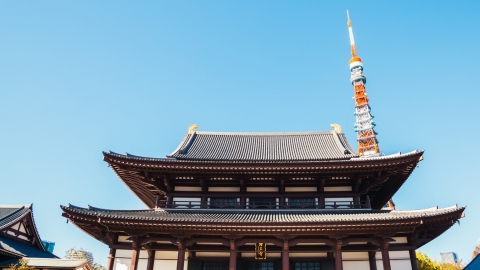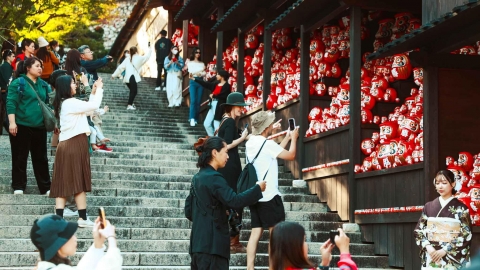From the resort, it only took me about five minutes by train to reach the temple. The temple stood tall on a hill jutting out into the sea, surrounded by waves and strong winds. The moment I set foot on it, I was overwhelmed by the scene that opened before my eyes: from the main hall, the bustling lobster farming village appeared, in the distance was the emerald green of the sea and the winding mountain range like arms embracing the space.



Tourists come to the temple by water
Between the sea and sky, a sacred place
The pagoda has a long history, formed from 1802 - 1808 under the direction of the founder Thien Phuoc. After many major renovations in 1826, 1938, 1962 and most recently in 2000, the pagoda still retains its solemnity. The name "Thien An" was also given by monk Thien Phuoc, with the meaning: "Thien" is the will of heaven, "An" is gratitude. Just two words that encapsulate the whole philosophy of life.
On the way from the ship landing to the pagoda, I passed a small temple, which was said to be where King Gia Long and some of his concubines stopped on their way to escape. After walking for about 5 minutes, I came to an empty land where there was a high rock with a statue of Buddha sitting on a white lotus platform, standing out against the dark blue sky and sea.

The temple of King Gia Long according to folk legend

Buddha statue sitting on a lotus pedestal placed on a large rock
From there, I slowly walked into the temple grounds, where there was a bright red Tam Quan gate - the color symbolizing happiness and luck. The temple's architecture is a combination of Vietnamese tradition and Japanese spirit. The curved tiled roof, white walls, and meditating statues of Guanyin in the temple grounds evoke the image of an ancient Vietnamese temple, but somewhere still faintly resembles the simplicity of a Japanese Zen garden. Those are the red wooden pillars, the torii gate - a traditional Japanese gate, often found at the entrance or inside Shinto shrines, symbolizing the boundary between the secular world and the sacred world, marking the entrance to a sacred place. This intersection makes me feel like I am walking through two cultures, between the sky and the sea.



The traditional Tori gate in Japanese culture
In the main hall, the Three Worlds Buddhas sit majestically, facing the sea. The Three Worlds Buddhas consist of three Buddha statues symbolizing three important time periods in the universe, with each Buddha being the ruler of an era: past - present - future. These three Buddhas bring truth, compassion and filial piety, helping sentient beings to dispel ignorance and attain enlightenment, transform suffering and find a peaceful life.
I stood quietly listening to the temple bells ringing, each reverberation blending with the sound of the waves offshore, creating a sacred yet melodious melody. That feeling melted all my worries away, leaving me with an indescribable peace.

The main shrine worships the Three Worlds Statue representing the past - present - future.

Front view of the temple
Stroll around the campus, immerse yourself in nature
Going deeper into the campus, I saw the entrance road with long stretches of white sand, a prominent red bridge and blooming cherry blossoms. The green lawn led down to the wind-catching watchtower, where just by raising the camera, any angle would become a beautiful photo. I tried to sit on the stone steps, looking out to sea. The sky was clear, the sea was blue, the waves rolled in layers of white caps, and behind me was the majestic pagoda. Every frame was as beautiful as a painting, but to me, what was more precious was the feeling of being truly immersed in nature, with every breath filled with the salty taste of the ocean.



The cherry blossom garden facing the sea gives visitors the feeling of being lost in the Land of the Rising Sun.
The special highlight in the temple yard is the hundred-year-old kơ nia tree - a natural treasure recognized by the Vietnam Record Organization as "Bach nien an cổ mộc" in 2021. The tree trunk is rough, the lush foliage covers a large area. Standing under the shade of the tree, listening to the leaves rustling in the sea breeze, I feel like I am touching a part of the ancient memory of this land. Perhaps many generations have sat under that tree, listening to the temple bells ringing, I feel strangely relieved.
Some visitors recounted that, on several occasions when they visited the temple, they were invited by the abbot to have vegetarian meals right here. I was not fortunate enough to experience that, but just imagining it already made me feel a sense of simplicity and warmth spreading. Here, people not only come to pray or perform rituals, but also to slow down, to listen to themselves in a vast and open space.



The meeting point of spirituality and tourism
Thien An Pagoda is not only a place for worship, praying for peace and salvation, but also a highlight in the Van Phong tourism picture. On major holidays such as Buddha's Birthday or Vu Lan, thousands of Buddhists and tourists flock here. But even on normal days, the pagoda still has its own charm, becoming a favorite destination for those who are passionate about photography or simply want to enjoy the peace. With a special location on a high hill overlooking the vast sea, every small corner here brings a sense of serenity.


From the temple grounds, visitors can take in the cool blue view of Van Phong Bay.
I chose to visit in the morning, when the dawn had just broken, the sunlight slanted through the tiled roof, reflecting on the sparkling sea. That was the moment when I saw the pagoda at its most beautiful, both majestic and intimate. People say that spring, the Lunar New Year, is also the ideal time to visit, when flowers and grass are in full bloom and the festive atmosphere spreads everywhere.
From the watchtower, where Van Phong waves blend into the distant sky, I understand why Thien An is called the most beautiful pagoda in the bay. Not only because of the scenery, but also because of the feeling of serenity that permeates every breath. And I know that when I leave, the ringing bells, the salty breeze and this moment of silence will remain in my heart for a long time.




































